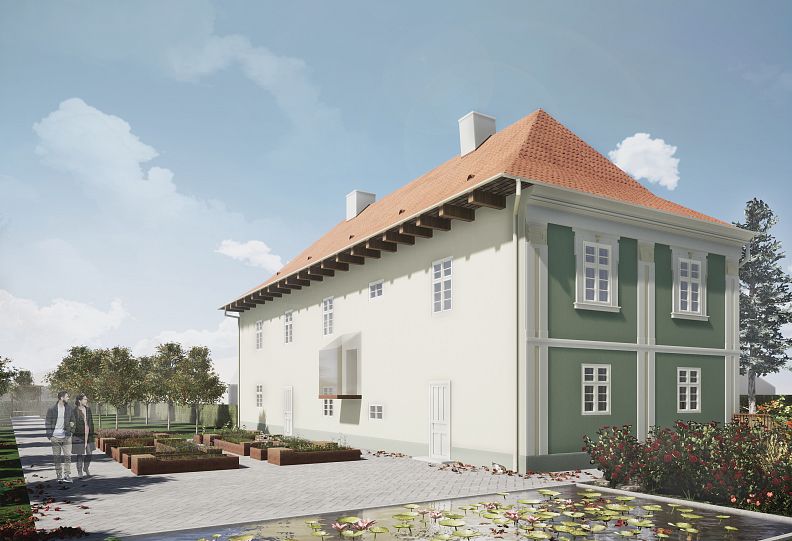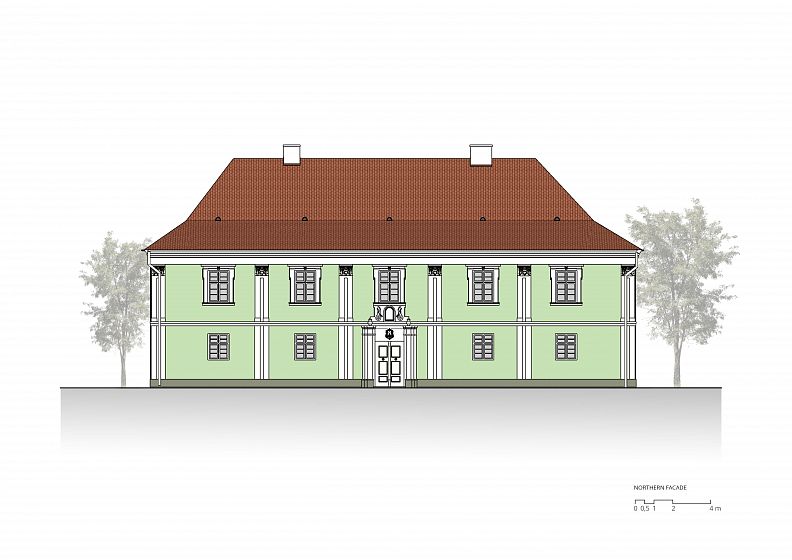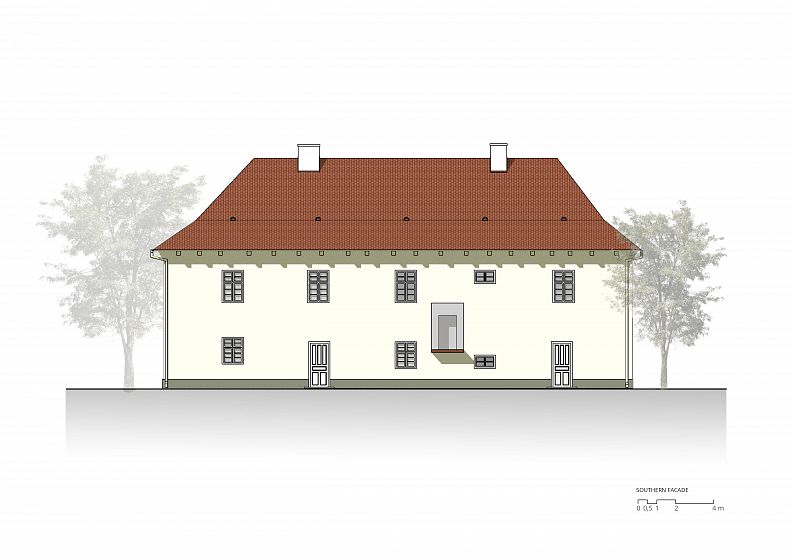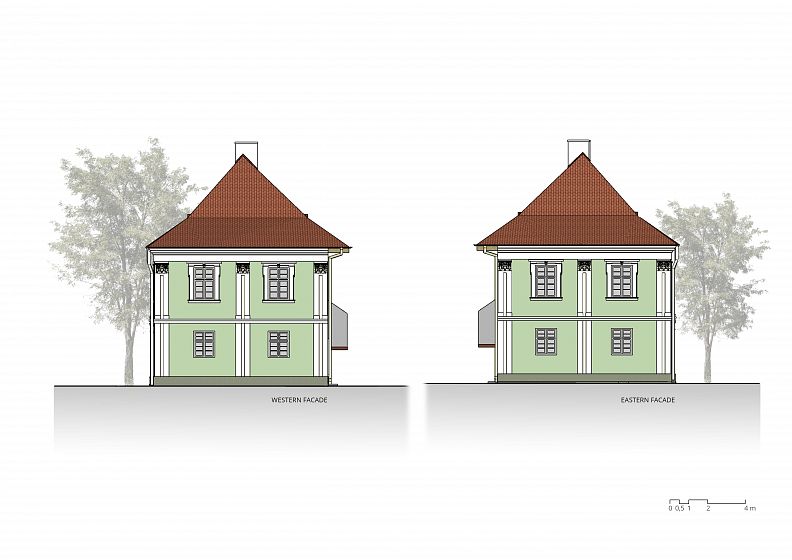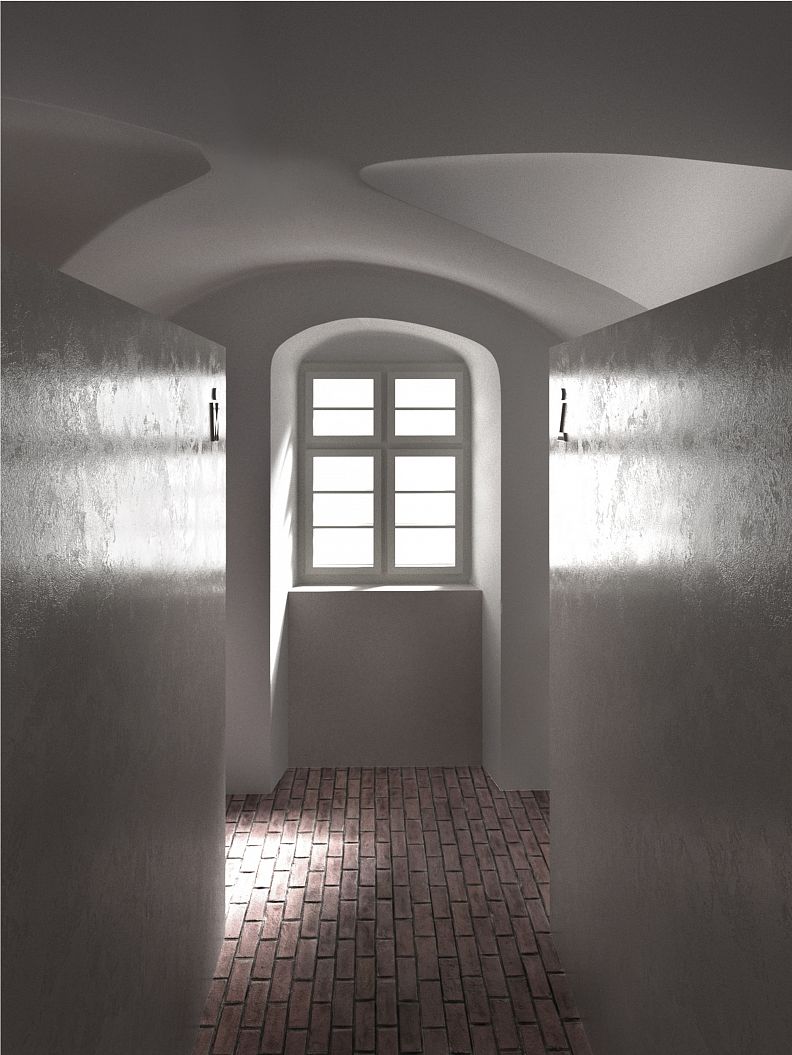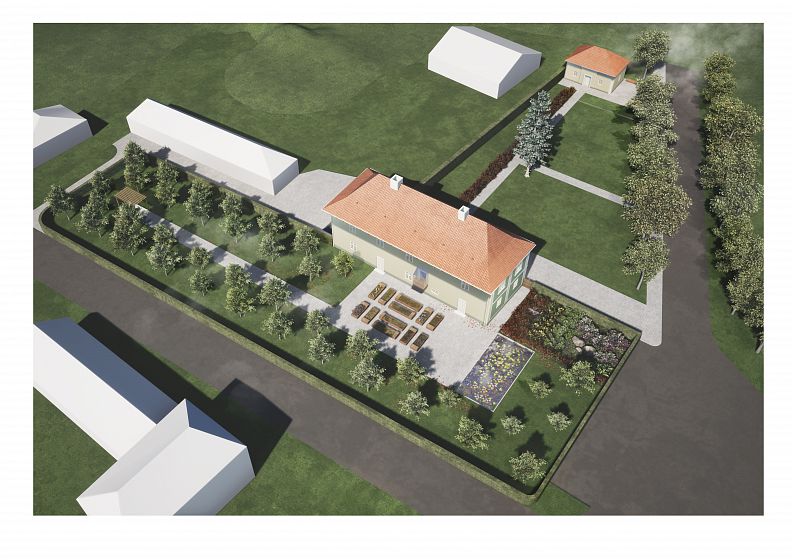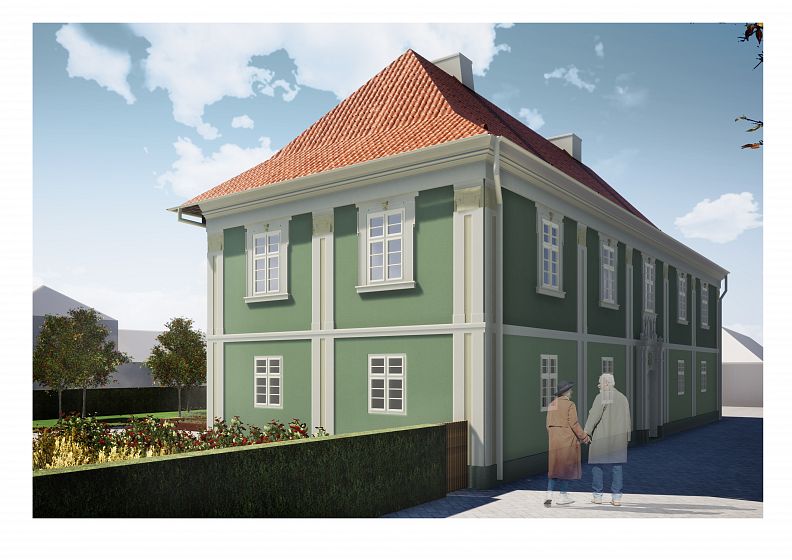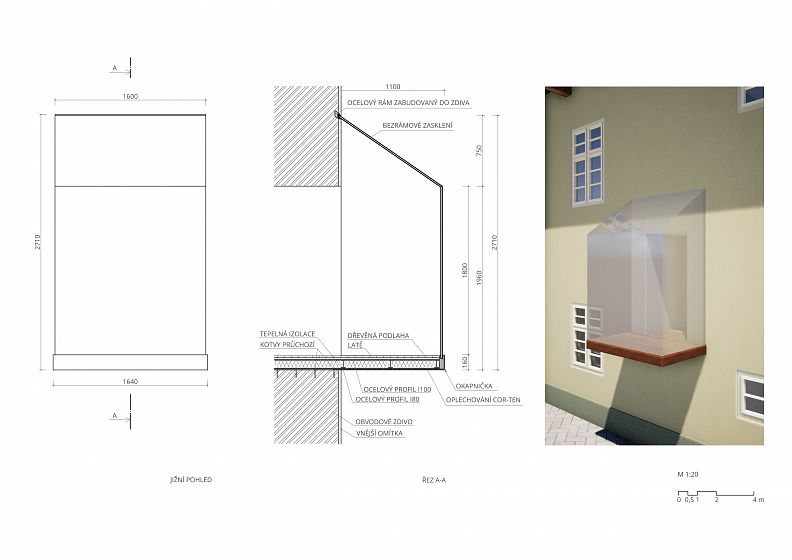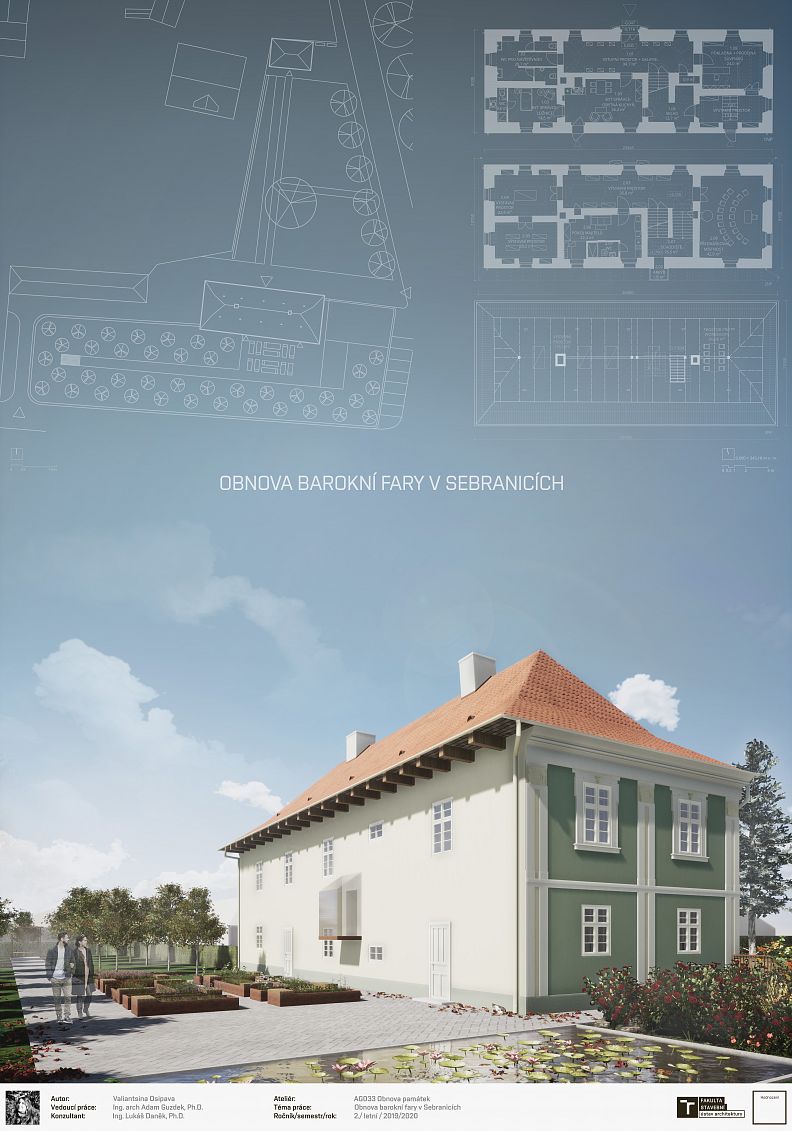The reconstruction of the rectory in Sebranice

Project idea
Main idea was to converse an old rectory to a puppet museum with separate apartments of administrator and owners. A part of a project was a territory around the rectory that was designed as two parks with different functions. A small building in the north part of the designed area was conversed to a social needs house.
Trying to save the authenticity of the baroque building and the spirit of the place I mostly returned the building to it’s original appearance. The southern façade is different from the others because of it’s different function: this part belongs to the fruit garden that is opened for visitors only after buying a ticket. The bay window has a shape of now not existing toilet. The color of the façade strengthens historical difference of this unpresentable yard part of the building.
Project description
The rectory was built in 1733. Further modifications took place in the years 1735-1736. After 1810, classicist modifications took place. The original vaults, stairs, beamed ceilings (even stucco ceilings), some floors, stoves are well-preserved. There are mostly original windows and doors. There are surface treatments (plaster, paving) and some doors and windows from the 20. century. The building has been protected as a monument since 1958.
The main entrance to the building is located on the north side. It enters an elongated rectangular space, which will serve as a gallery for exhibitions of local artists’ artworks. On the right side there are toilets for visitors, on the left is the reception, which also serves as a souvenir shop. There is the door to the administrator's apartment opposite the entrance, which consists of a living kitchen and a bedroom with sanitary facilities. Through the reception area you can go to the exhibition space (also to the area of the cellar with an exhibition of especially scary puppets) and to the orchard. There is a storage space under the stairs, accessible both from the administrator's apartment and from the exhibition space. The main staircase is located opposite the main entrance. A bay window with a view of the orchard is accessible from the mezzanine area. The bay window is also used to illuminate the stairwell. On the 2nd floor there are exhibition spaces and in the least monumentally valuable room is an owners‘ apartment with a sanitary facility. The large room on the east side is used as a lecture room. Stands next to the walls (room 2.03), niches in the walls and stands in the openspace (2.04, 2.05) are used for the exhibition. The space under the roof is also used for the exhibition.
The existing color of the facades (Reseda green) is left in the exterior, except of the southern facade, where it will use a soft honey shade; the missing parts of the decoration are added, the pilasters were stretched down to the plinth, the window frames were changed to the original ones. All window frames will be painted in a soft cream shade. Designed on the south facade, the bay window has a simple shape and is entirely glazed, thus achieving maximum illumination of the interior.
In the interior, plasters are renewed, for which lime plaster is used. The shade of the walls and ceilings is white, with the exception of the beamed ceilings, which in room 1.07 will remain unpainted and in room 1.08 will be restored to their original painted form, which is possible thanks to the preserved painted parts. Plasters from the last century will be changed to lime with a white tint of the surface. Large-format ceramic tiles will be used in light shades where tiling is required. In the rooms with the missing floor, new floors will be made with the use of IGLÚ fittings and with a wooden tread layer, in the areas of the sanitary facility - with a brick floor. The stair treads will be partially restored as close as possible to their original form.
The small house is designed as a social-needs house with the possibility of renting for celebrations. The interior space consists of a large room with a table, a kitchen and with the access to a sanitary facility.
The exterior of the small house will be supplemented by a portal around the front door. The façade will be painted in the same shade as the southern façade of the rectory, which is honey yellow. Window frames and decorative elements will be slightly creamy. The window openings are reduced to their original dimensions. The door opening, on the other hand, enlarges. The material and color solution of the exterior and interior is similar to that of the rectory building, which increases the effect of both buildings and adjacent gardens as a whole.
The southern garden serves as an open orchard with flower and herb beds and a water area. There is also a barbecue area with a gazebo. The northern garden is open to the public and is visually separated by a tree-lined alley along a public sidewalk. The rectory and the house are connected by a sidewalk in the axis of both buildings. The design respects the existing tree (silver spruce). In the eastern part of the plot are designed parking spaces with a total of 10, including one parking space for the immobile. Minor landscaping is needed (removal of the high jump at the main entrance to the rectory and along the south facade).
Technical information
The rectory is a two-storey building covered with a gabled roof with double-sided hips. The rectangular floor plan has dimensions of approximately 25.4 x 9.1 m. In terms of load-bearing structures, it is a double wing. The masonry is almost entirely made of solid bricks, in some places there is also stone masonry. Most of the rooms in the ground floor are covered with barrel vaults. In the eastern part there are wooden beamed ceilings. All rooms upstairs are covered with beamed ceilings with stucco ceilings. The truss is wooden.
A fundamental problem in terms of design is the loss of stability of the building, caused by the movement of masonry in all directions. Another problem is the increased humidity of the masonry.
